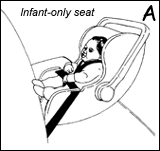 |
| Infants
under 1 year and less than 20 lbs.
face rear only. |
 |
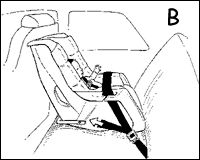 |
| Infants
less than 1 year, over 20 lbs. ride
in a seat approved for heavier
infants rear facing. |
 |
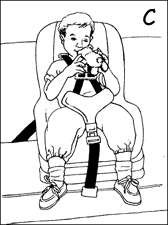 |
| Child
over 1 and at least 20 lbs. faces
the front. |
 |
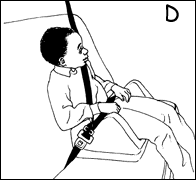 |
| Belt-positioning
booster is used with both lap and
shoulder belts. |
 |
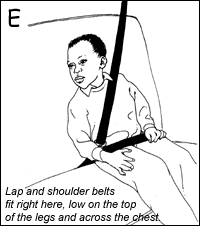 |
| Auto
booster seats are for children who
have outgrown safety seats, at about
40 pounds. |
|
 |
Quick
safety seat checkup
Does your child ride in
the back seat? The
back seat is generally the safest place in a
crash. If your vehicle
has a passenger air bag, it is essential for
children 12 and under to ride in back.
Does your child ride
facing the right way?
- Infants should ride in
rear facing restraints, preferably in
the back seat, until about age 1 and at
least 20-22 lbs (A). Infants who
weigh 20 lbs. before 1 year of age
should ride in a restraint approved for
higher rear facing weights (B).
Always read your child restraint owner
manual for instructions on properly
using the restraint.
- Children over age one
and at least 20 pounds may ride facing
forward (C).
Does the safety belt
hold the seat tightly in place?
- Put the belt through
the right slot. If your safety seat can
be used facing either way, use the
correct belt slots for each direction.
- The safety belt must
stay tight when securing the safety
seat. Check the vehicle owner's manual
for tips on using the safety belts.
Is the harness buckled
snugly around your child?
- Keep the straps over
your child’s shoulder. The harness
should be adjusted so you can slip only
one finger underneath the straps at your
child's chest. Place the chest clip at
armpit level.
Does your child over
40 pounds have the best protection
possible?
- Keep your child in a
safety seat with a full harness as long
as possible, at least until 40 pounds (C).
Then use a belt-positioning booster seat
which helps the adult lap and shoulder
belt fit better.
- A belt-positioning
booster seat is preferred for children
between 40-80 pounds (D). It is
used with the adult lap and shoulder
belt. Check on special products for
heavy children too active to sit still
in a booster.
How should a safety
belt fit an older child?
- The child must be tall
enough to sit without slouching, with
knees bent at the edge of the seat, with
feet on the floor. The lap belt must fit
low and tight across the upper thighs.
The shoulder belt should rest over the
shoulder and across the chest (E).
Never put the shoulder belt under the
arm or behind the child's back. The
adult lap and shoulder belt system alone
will not fit most children until they
are at least 4'9" tall and weigh
about 80 pounds.
For more
information, go to the
National Highway Transportation Safety
Administration at www.nhtsa.dot.gov
Even
the "safest" seat may not
protect
your child if it isn't used correctly.
|